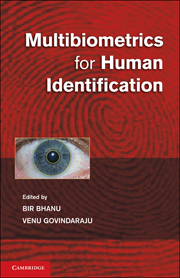Book contents
- Frontmatter
- Contents
- List of Contributors
- Preface
- Introduction
- PART I MULTIMODAL AND MULTISENSOR BIOMETRIC SYSTEMS
- 1 Multimodal Ear and Face Modeling and Recognition
- 2 Audiovisual Speech Synchrony Detection by a Family of Bimodal Linear Prediction Models
- 3 Multispectral Contact-Free Palmprint Recognition
- 4 Face Recognition under the Skin
- PART II FUSION METHODS IN MULTIBIOMETRIC SYSTEMS
- PART III HYBRID BIOMETRIC SYSTEMS
- PART IV DATABASES AND SECURITY
- PART V PERFORMANCE OF MULTIBIOMETRIC SYSTEMS
- Plate section
1 - Multimodal Ear and Face Modeling and Recognition
from PART I - MULTIMODAL AND MULTISENSOR BIOMETRIC SYSTEMS
Published online by Cambridge University Press: 25 October 2011
- Frontmatter
- Contents
- List of Contributors
- Preface
- Introduction
- PART I MULTIMODAL AND MULTISENSOR BIOMETRIC SYSTEMS
- 1 Multimodal Ear and Face Modeling and Recognition
- 2 Audiovisual Speech Synchrony Detection by a Family of Bimodal Linear Prediction Models
- 3 Multispectral Contact-Free Palmprint Recognition
- 4 Face Recognition under the Skin
- PART II FUSION METHODS IN MULTIBIOMETRIC SYSTEMS
- PART III HYBRID BIOMETRIC SYSTEMS
- PART IV DATABASES AND SECURITY
- PART V PERFORMANCE OF MULTIBIOMETRIC SYSTEMS
- Plate section
Summary
Introduction
Biometric systems deployed in current real-world applications are primarily unimodal – they depend on the evidence of a single biometric marker for personal identity authentication (e.g., ear or face). Unimodal biometrics are limited, because no single biometric is generally considered both sufficiently accurate and robust to hindrances caused by external factors (Ross and Jain 2004).
Some of the problems that these systems regularly contend with are the following: (1) Noise in the acquired data due to alterations in the biometric marker (e.g., surgically modified ear) or improperly maintained sensors. (2) Intraclass variations that may occur when a user interacts with the sensor (e.g., varying head pose) or with physiological transformations that take place with aging. (3) Interclass similarities, arising when a biometric database comprises a large number of users, which results in an overlap in the feature space of multiple users, requires an increased complexity to discriminate between the users. (4) Nonuniversality – the biometric system may not be able to acquire meaningful biometric data from a subset of users. For instance, in face biometrics, a face image may be blurred because of abrupt head movement or partially occluded because of off-axis pose. (5) Certain biometric markers are susceptible to spoof attacks – situations in which a user successfully masquerades as another by falsifying their biometric data.
- Type
- Chapter
- Information
- Multibiometrics for Human Identification , pp. 9 - 30Publisher: Cambridge University PressPrint publication year: 2011
- 1
- Cited by



